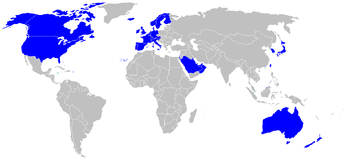First World: Difference between revisions
No edit summary |
I'm certain this was a slight error, Macao being part of China instead of the Malta islands? |
||
| Line 74: | Line 74: | ||
|• {{flagcountry|Czech Republic}} || • {{flagcountry|Luxembourg}} || • {{flagcountry|Trinidad and Tobago}} |
|• {{flagcountry|Czech Republic}} || • {{flagcountry|Luxembourg}} || • {{flagcountry|Trinidad and Tobago}} |
||
|- |
|- |
||
|• {{flagcountry|Denmark}} || • {{flagcountry|Macao}} || • {{flagcountry|United Arab Emirates}} |
|• {{flagcountry|Denmark}} || • {{flagcountry|Macao}}, China || • {{flagcountry|United Arab Emirates}} |
||
|- |
|- |
||
|• {{flagcountry|Estonia}} || • {{flagcountry|Malta}} |
|• {{flagcountry|Estonia}} || • {{flagcountry|Malta}} || • {{flagcountry|United Kingdom}} |
||
|- |
|- |
||
|• [[Faeroe Islands]] || • {{flagcountry|Monaco}} || • {{flagcountry|United States}} |
|• [[Faeroe Islands]] || • {{flagcountry|Monaco}} || • {{flagcountry|United States}} |
||
Revision as of 03:28, 8 July 2007


| 0.950 and over 0.900–0.949 0.850–0.899 0.800–0.849 0.750–0.799 0.700–0.749 | 0.650–0.699 0.600–0.649 0.550–0.599 0.500–0.549 0.450–0.499 0.400–0.449 | 0.350–0.399 0.300–0.349 under 0.300 N/A |


The term "First World" refers to countries that are democracies, which are technologically advanced, and whose citizens have a high standard of living.
The terms First World, Second World, and Third World were used to divide the nations of Earth into three broad categories. The three terms did not arise simultaneously. After World War II, people began to speak of the NATO and Warsaw Pact countries as two major blocs, often using such terms as the "Western Bloc" and the "Eastern Bloc". The two "worlds" were not numbered. It was eventually pointed out that there were a great many countries that fit into neither category, and in 1952 French demographer Alfred Sauvy coined the term "Third World" to describe this latter group; retroactively, the first two groups came to be known as the "First World" and "Second World". (As Hannah Arendt explains, "The Third World is not a reality but an ideology.")
There were a number of countries that did not fit comfortably into this neat definition of partition, including Switzerland, Sweden, and the Republic of Ireland, who chose to be neutral. Finland was under the Soviet Union's sphere of influence but was not communist, nor was it a member of the Warsaw Pact. Austria was under the United States' sphere of influence, but in 1955, when the country became a fully independent republic, it did so under the condition that it remain neutral. Turkey and Greece, both of which joined NATO in 1952, were not predominantly in Western Europe and were not industrialized. Spain did not join NATO until 1982, towards the end of the Cold War and after the death of the authoritarian dictator Francisco Franco.
In recent years, as many "developing" countries have industrialized, the term Fourth World has been coined to refer to countries that have "lagged behind" and still lack industrial infrastructure. In contrast, countries that were previously considered developing countries and that now have a more advanced economy, yet not fully developed, are grouped under the term Newly-industrialized countries or NIC.
Some nations have developed their own classification scheme consisting of the "Third World", and the "Two-Thirds World". This system is similar to the former in that it also reflects economic status or behaviour. In terms of material resources, the "Third World" takes just one third of the pie, while the "Two-Thirds World" takes two-thirds of the pie.
High income countries
While there is no precise definition of the "first" or "rich" world, the World Bank does categorize countries as high, upper and lower middle as well as low income. While this list is reflective of the "rich world," second world countries, Slovenia and the Czeck Republic are included. High income countries are thereby defined as countries with a Gross National Income per capita of $10,726 of more. According to the World Bank the following 60 countries were categorized as high income economies as of 2007:[1]
| • |
• |
• |
| • Antigua and Barbuda | • |
• |
| • |
• |
• |
| • |
• |
• |
| • |
• |
• |
| • |
• |
• |
| • |
• |
• |
| • |
• |
• |
| • |
• |
• |
| • |
• |
• |
| • |
• |
• |
| • |
• |
• |
| • |
• |
• |
| • Channel Islands | • |
• |
| • |
• |
• |
| • |
• |
• |
| • |
• |
• |
| • |
• |
• |
| • Faeroe Islands | • |
• |
| • |
• |
• Virgin Islands (U.S.) |
IMF advanced economy list

According to the International Monetary Fund the following 31 countries are classified as "advanced economies:"[2]
| • |
• |
• |
| • |
• |
• |
| • |
• |
• |
| • |
• |
• |
| • |
• |
• |
| • |
• |
• |
| • |
• |
• |
| • |
• |
• |
| • |
• |
• |
| • |
• |
• |
| • |
References
- ^ a b "World Bank. (2007). Data & Statistics: Country Groups". Retrieved 2007-06-20.
- ^ "IMF. (April 2007). World Economic Outlook". Retrieved 2007-07-06.
